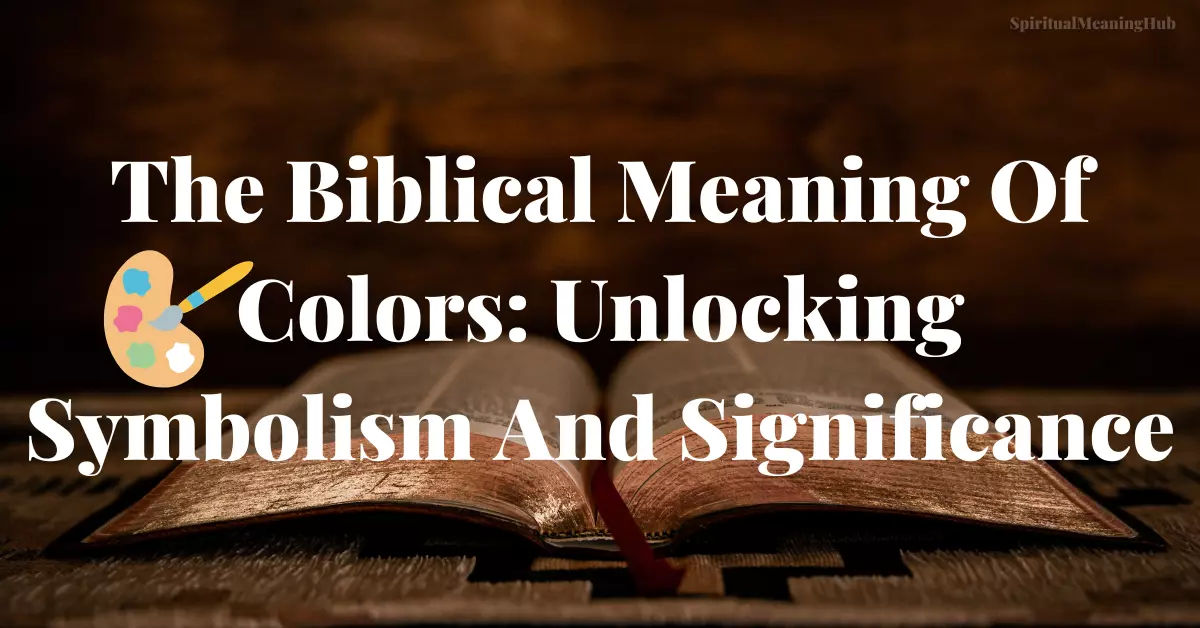Colors have always played a fascinating role in human history, culture, and spirituality. And guess what? The Bible is no exception! Yep, colors in the Bible have some super cool symbolic meanings that carry deeper messages and spiritual truths.
So, get ready to dive into this awesome article where we’ll explore the biblical meaning of colors and unravel their hidden secrets.In this exciting journey, we’ll discover the significance of different colors in the Bible and what they represent.
From the vibrant red that symbolizes Jesus Christ’s sacrificial blood to the calming blue that represents the heavenly realms, we’ll unravel the stories behind each color. We’ll even delve into secondary colors like orange, green, and purple, and find out what they’re all about.
So, let’s buckle up and explore the colorful world of the Bible together, where meanings come alive and stories unfold in vivid hues!

The Significance of Primary Colors in the Bible
Red
Red is a vibrant color that catches the eye. In the Bible, it is associated with the blood of Jesus Christ. His blood was shed on the cross to save us from our sins, and it represents God’s love for us. The lamb’s blood was also used to atone for sins, as well as salvation. It is a powerful reminder of God’s love for us and the ultimate sacrifice he made.
Blue
Blue is a calming color that represents heaven and the Holy Spirit. It is often associated with authority and royalty. Blue is also the color of the sky, which reminds us of God’s vastness and infinite power. In the Bible, blue is used to represent God’s law, and it is also associated with divine revelation.
Yellow
Yellow is a bright, cheerful color that represents faith and glory of God. It is associated with anointing and joy. In the Bible, yellow is used to represent God’s presence and his glory. It is also a reminder to have faith in God and trust that he will provide for our needs.
The Significance of Secondary Colors in the Bible
Orange
Orange is a warm, vibrant color that represents fire and passion. In the Bible, orange is used to represent the fire of God, which purifies and refines us. It is also associated with deliverance and passionate praise. Orange reminds us to worship God with passion and zeal.
Green
Green is a refreshing color that signifies praise, growth, prosperity, new beginnings, flourishing, and restoration. In the Bible, green is often associated with the flourishing of nature and the growth of crops. It represents spiritual growth, prosperity, and the blessings that come from walking in obedience to God’s word.
Purple
Purple is a rich, royal color that represents priesthood, kingship, and wealth. It is associated with mediation and the Holy Spirit. In the Bible, purple is used to represent the robe of the high priest and his position as mediator between God and man. It is also associated with royalty and kingship. Purple represents the authority and power of God’s chosen leaders. It signifies wealth and abundance as well.
The Significance of Other Colors in the Bible
Black
Black is a dark, somber color that represents sin, darkness, and death. It is a symbol of affliction, humiliation, and calamity. In the Bible, black is used to represent the earth and its inhabitants, who are lost in sin and darkness. Black reminds us of our need for salvation and redemption.
Pink
Pink/Fuchsia is a soft, delicate color that represents right relationship with God. It is associated with love, compassion, and tenderness. In the Bible, pink is used to represent God’s love for us and his compassion towards us. It is a reminder that we are beloved children of God and that he cares for us deeply.
Brown
Brown is a warm, earthy color that represents the end of a season, weariness, and the humbleness of humanity. In the Bible, brown signifies the weariness and struggles of the human condition. It reminds us of our need for God’s strength and guidance, especially during challenging times.
Scarlet
Scarlet is a rich, deep color that represents royalty and wealth. It is associated with fine linen used for the tabernacle. In the Bible, scarlet is used to represent the blood of Jesus Christ, who is the king of kings and Lord of lords. Scarlet reminds us of our royal heritage as children of God and our position as joint heirs with Christ.
Silver
Silver is a shiny, reflective color that represents purity and divinity. It is associated with the word of God, salvation, and redemption. In the Bible, silver is used to represent the redemption of God’s people and their purification. It is also associated with the atonement and truth. Silver reminds us of God’s faithfulness and his promise to redeem us.
White
White is a pure, bright color that represents righteousness, light, and conquest. It is associated with angels, saints, and the peace of God. In the Bible, white is used to represent the Bride of Christ, who is made pure and blameless through his blood. It is also associated with the harvest and the joy of victory. White reminds us of our victory in Christ and our future hope.
Gold
Gold is a precious metal that symbolizes glory, divinity, and eternal deity. It represents the majesty and righteousness of God. In the Bible, gold is often associated with kingship, as seen in the golden crowns and ornaments worn by royalty. It also represents the foundation and altar of God, as well as the beauty and preciousness of His presence.
Wine
Wine is a rich, deep color that signifies new birth, multiplication, and overflow. In the Bible, wine represents the abundance and blessings that come from God. It is a symbol of celebration and joy, as well as the overflowing grace and goodness of the Lord.
Sapphire
Sapphire is a brilliant blue color that represents the law, commandments, grace, and the Holy Spirit. In the Bible, sapphire is associated with divine revelation and wisdom. It signifies the importance of following God’s commandments and seeking His guidance through the Holy Spirit.
Turquoise
Turquoise is a serene, calming color that represents the river of God, sanctification, healing, and the New Jerusalem. In the Bible, turquoise is associated with the cleansing and purifying work of the Holy Spirit. It symbolizes the healing and restoration that comes from God’s presence and the promise of a new and glorious future.
Amber
Amber is a warm, radiant color that signifies the glory of God, judgment upon sin, and endurance. In the Bible, amber is associated with the brightness of God’s glory and His righteous judgment. It also symbolizes the endurance and steadfastness of God’s people in the face of trials and tribulations.
List of Colors in the Bible and Their Meanings
To make it easier to understand, we’ve provided a table below that lists the biblical meaning of colors.
| Color | Meaning |
|---|---|
| Red | Symbolizes Jesus’ sacrifice and God’s love, associated with salvation. |
| Blue | Represents heaven, the Holy Spirit, authority, and divine revelation. |
| Yellow | Signifies faith, God’s glory, and joy. |
| Black | Symbolic of sin, darkness, and the need for redemption. |
| Orange | Represents fire, passion, deliverance, and worship. |
| Green | Signifies growth, prosperity, and spiritual blessings. |
| Pink | Represents a right relationship with God and His love and compassion. |
| Brown | Symbolizes weariness and the need for God’s guidance. |
| Scarlet | Represents royalty, wealth, and the blood of Jesus. |
| Silver | Symbolic of purity, redemption, and God’s faithfulness. |
| White | Signifies righteousness, victory, and purity in Christ. |
| Purple | Represents priesthood, kingship, and God’s chosen leaders. |
| Gold | Symbolizes glory, divinity, and the majesty of God. |
| Wine | Signifies abundance, celebration, and overflowing grace. |
| Sapphire | Represents the law, grace, and seeking God’s guidance. |
| Turquoise | Symbolizes sanctification, healing, and the promise of a glorious future. |
| Amber | Signifies God’s glory, judgment, and endurance in trials. |
Conclusion
Remember, as you navigate the vibrant world of colors in the Bible, reflect on their deeper meanings and embrace the transformative power they hold. May this comprehensive guide illuminate your path and inspire a deeper understanding of God’s truth.
In conclusion, the biblical meaning of colors offers a captivating tapestry of symbolism and significance. Each color carries its own unique message, shedding light on various aspects of our faith and spiritual journey. Understanding these symbolic representations allows us to deepen our connection with God and gain a profound appreciation for the intricacies of His Word.
FAQs
What color represents faith in the Bible?
The color blue represents faith in the Bible. It symbolizes heavenly qualities, divine presence, and spiritual purity.
What color represents royalty in the Bible?
Purple represents royalty in the Bible. It is associated with power, wealth, and nobility.
What color symbolizes purity in the Bible?
White symbolizes purity in the Bible. It represents holiness, righteousness, and spiritual cleanliness.
What color represents sin and darkness in the Bible?
The color black represents sin and darkness in the Bible. It signifies spiritual emptiness, mourning, and separation from God.
What color represents growth and abundance in the Bible?
The color green represents growth and abundance in the Bible. It symbolizes flourishing vegetation, fruitful harvests, and spiritual nourishment.
What color symbolizes divinity and glory in the Bible?
Gold symbolizes divinity and glory in the Bible. It represents the radiance of God’s presence, the majesty of His kingdom, and spiritual riches.
What color represents heavenly realms and the divine in the Bible?
The color blue represents heavenly realms and the divine in the Bible. It symbolizes the presence of God, the celestial nature of the heavens, and spiritual transcendence

